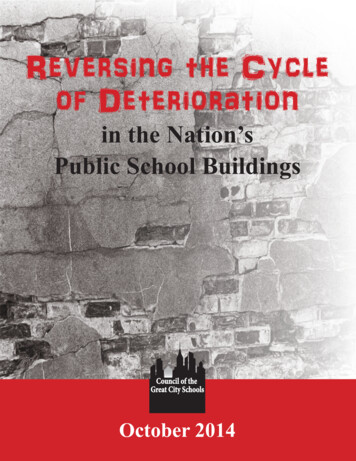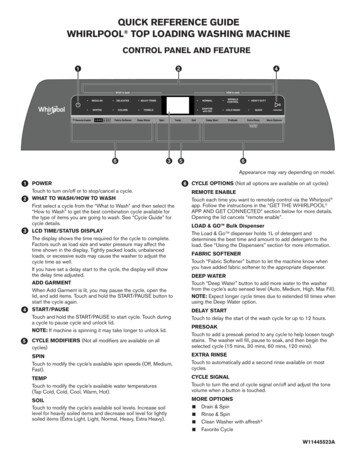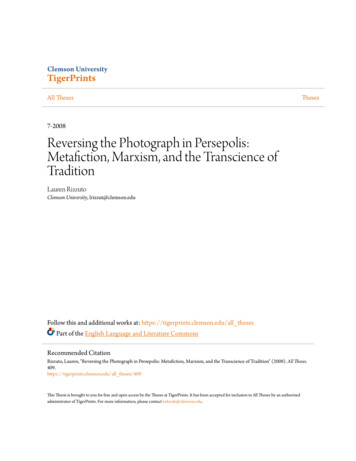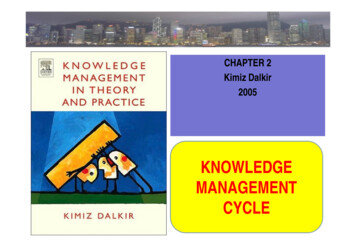
Transcription
Reversing the Cycleof Deteriorationin the Nation’sPublic School Buildings October 2014
2014Reversing the Cycle ofDeterioration in theNation’s Public SchoolBuildingsCOUNCIL OF THE GREAT CITY SCHOOLS
Table of ContentsIntroduction. . 1Chapter 1. Determining the Relationships among School Building Conditions, StudentAchievement, School Safety, and Community Relations . 5Chapter 2. Calculating School Building Life-Cycle Investments, Life-Cycle Costs, and the Costsof Deferring Maintenance . 11Chapter 3. Facilities Condition Assessment and Major Repair/Replacement Program Planning. 21Chapter 4. Identifying Successful Strategies and Methods Used in Maintaining School Buildingsand Equipment . 27Chapter 5. Determining Correct Methods and Amounts for Allocating Resources to MaintainSchool Buildings and equipment . 39Chapter 6. Creating a Model for Effective Community Relations . 47Chapter 7. Mining Resources for Maintaining School Buildings and Equipment . 53Facilities Task Force . 63About the Council . 70
ForewordThe Deferred Maintenance Task Force Report – “Reversing the Cycle of Deterioration in theNation’s Public School Buildings” – is the culmination of two years of work by over two dozenschool facilities and finance executives from member districts and industry, all of whom offeredtheir considerable expertise pro bono.Simply put, the report describes how school districts, financially squeezed over long periods oftime, made economic decisions that reduced the most cost-effective types of maintenance work:preventive and predictive maintenance. The result of those decisions “to save money” will, in thelong term actually increase the amount and frequency of much more expensive breakdown repairand replacement work.As funds continued to be inadequate, the higher costs of breakdown repair work are forcingdistricts to make fewer repairs, which accelerates the deterioration of buildings and componentsystems. Ultimately, districts experienced and will continue to experience premature failure ofbuildings and systems, and are forced to borrow large sums of capital funds (with theiraccompanying debt service costs) to upgrade and/or replace facilities. Sadly, new buildings arelikely to receive the same lack of preventive and predictive maintenance, thereby repeating thecycle of deterioration.The report contains contemporary references that link the conditions of school buildings tostudent achievement and a variety of other issues. It also provides information and references toa variety of strategies that have proven successful in reversing the cycle of deterioration.The Council of the Great City Schools expresses its profound appreciation for the work of theTask Force that was co-chaired by Bruce Husson, retired Superintendent, Sweetwater UnionHigh School District and former Assistant Superintendent, Business Services, San Diego UnifiedSchool District; and Fred Schmitt retired Chief Finance Officer, Norfolk Public Schools. TheCouncil urges its member districts to carefully review the report and embrace and employ theconcepts described in it.Michael CasserlyExecutive DirectorCouncil of the Great City SchoolsRobert CarlsonDirector, Management ServicesCouncil of the Great City Schools
Reversing the Cycle of Deterioration in the Nation’s PublicSchool BuildingsIntroductionAcross the nation, large urban school districts are experiencing premature and rapidlyaccelerating deterioration of school buildings. The conditions of buildings and equipment, mostimportantly in classrooms and school support spaces, are deteriorating to the point of hinderingthe core mission of schools: educating children.Data from multiple authoritative sources reveal that the deteriorating condition of schools has adirect and significant impact on the achievement of students and the effectiveness of teachers.References to such research will appear throughout this report.Further, the lack of effective planned, predictive, and preventive maintenance of facilitiessignificantly increases the rate of decay, and significantly increases the overall costs ofmaintaining buildings and equipment at the level that allows them to effectively serve theiroccupants and to achieve their designed life expectancy.Note: References to “maintenance” throughout this report focus on planned, predictive,breakdown, and replacement work. For the purposes of this report, custodial, landscape, andutilities costs are not included or considered.“Deferred Maintenance” is a term that will be used throughout this report. Deferredmaintenance is a measure of the preventive and regular maintenance, minor and capital repairs,and capital system and component replacements that are needed to extend the life of the facilityto achieve its projected life expectancy but that have been postponed to a future date beyond therecommended service interval or breakdown.Deferred maintenance is calculated by subtracting the accumulated expenditures for preventiveand regular maintenance, minor and capital repairs, and capital system and componentreplacement from the current replacement value of a facility accumulated over the projected lifeof the facility—usually factored as a 25- to 50-year facility life.Deferred maintenance results ina)b)c)d)e)increased overall costs of managing and operating facilities;increased incidence of unplanned and more costly urgent and emergency repairs;increased incidence of disruptions to delivering instructional programs;increased risk of defaults on warranties of equipment and building components; andpremature failure of buildings and equipment, requiring significant and often unbudgetedcapital expenditures and their accompanying debt-service costs.Appendix I-1 is a February 2011 report by the 21st Century School Fund summarizing the scaleand conditions of United States public school buildings and grounds. Arguably the mostcompelling statistic presented is that, nationwide in 2010, school districts had an estimated 271billion of deferred maintenance in their buildings and grounds, averaging 4,883 per student.More recent data will no doubt show increases in both of those numbers. The report also1
Reversing the Cycle of Deterioration in the Nation’s Public School Buildingsindicates a top-level list of issues relating to what differences facility conditions make to childrenand adults. This topic will be covered in greater detail in Chapter 1.Appendix I-2 is a March 2014 report by the U.S. Department of Education Institute ofEducation Sciences titled, “Condition of America’s Public School Facilities, 2012-1.”Appendix I-3 is a January 2013 report by the Center for Green Schools titled “2013 State of ourSchools Report”. The report summarizes the conditions of schools in the United States andprovides top-level assessments of the impacts and effects of those conditions.At its annual Chief Operating Officer conference in April 2013, the Council of the Great CitySchools (Council) established a focused agenda on the subject of facilities management. Inattendance were representatives of 56 Council member and other school districts andrepresentatives of 14 companies that serve school districts in the capacity of providing facilitiesmanagement support. Over the course of two days, the conference produced a large amount ofinformation relevant to the issues stated above and set in motion a process toinform the nation’s school districts and public about the magnitude of the issues;recommend strategies and tactics to reverse the deterioration cycle;improve the management of school buildings and equipment;inform school districts about traditional and nontraditional funding sources for managingbuildings and equipment; ande) recommend strategies for school districts to consider in order to make more effective useof operating and capital resources dedicated to managing buildings and equipment.a)b)c)d)Appendix I-4 is a report that summarizes the discussions at the 2013 COO Conference, andoutlines a course of action to be undertaken by the Council over the next year.The process began with the establishment of a Deferred Maintenance Task Force (DMTF),comprised of representatives of Council member school districts and private companies. Thetask force is co-chaired by Bruce A. Husson, retired superintendent of Sweetwater Union HighSchool District and former assistant superintendent, business services of San Diego UnifiedSchool District, San Diego, California; and by Frederick J. Schmitt, retired chief financial officerof Norfolk Public Schools, Norfolk, Virginia. The membership roster of the DMTF, followed bya compendium of bios of the task force members, is included in this section of the report asAppendix I-5.The DMTF agreed to organize the project into two phases. Phase 1 was “Defining the Problem.”It consists of the first three chapters:Chapter 1: “Determining the Relationships between Building Conditions and StudentAchievement, School Safety and Community Relations”Chapter 2: “Calculating School Building Life-Cycle Investments, Life-Cycle Costs, and theCosts of Deferring Maintenance”Chapter 3 is “Facilities Condition Assessment and Major Repair/Replacement ProgramPlanning”Council of the Great City Schools2
Reversing the Cycle of Deterioration in the Nation’s Public School BuildingsThe DMTF organized itself into subgroups according to the three chapters of Phase 1. FromApril to September 2013, the DMTF conferred seven times via conference calls and innumerabletimes within and among the chapter subgroups via e-mail and telephone in order to assemble theinformation contained in Phase 1 of the project.Following the presentations at the 2013 CFO Conference and the CGCS Fall Conference, theDMTF proceeded with Phase 2 of the project – “Road Map to Solutions” (Chapters 4–7 of thereport).Chapter 4: “Identifying Successful Strategies and Methods Used in Maintaining SchoolBuildings and Equipment”Chapter 5: “Determining Correct Methods and Amounts for Allocating Resources to MaintainSchool Buildings and Equipment”Chapter 6: “Creating a Model for Effective Community Relations”Chapter 7: “Mining Resources for Maintaining School Buildings and Equipment”The development of Phase 2 commenced at the COO Conference in April 2014 and proceededthrough September. As happened with Phase 1, the development of the four chapters wasaccomplished by subgroups of the DMTF. During the Phase 2 development the DMTF metseven times via conference calls and met many more times in meetings of the subgroups.Deferred Maintenance Task Force Co-Chairs:Bruce Husson, Retired Superintendent, Sweetwater Union High School District, Chula Vista,CA, and former Assistant Superintendent for Business, San Diego Unified School District, SanDiego, CA.Fred Schmitt, retired Chief Financial Officer of Norfolk Public Schools, Norfolk, VA.References and ResourcesAppendix I-1: PK-12 Public School Facility Infrastructure Fact Sheet; February 2011; 21stCentury School Fund, Washington, DCAppendix I-2: Condition of America’s Public School Facilities, 2012-13; U.S. Department ofEducation, Institute of Education Sciences, March 2014, Washington, DCAppendix I-3: 2013 State of our Schools Report, March 2013, U.S. Green Building Council,The Center for Green Schools, Washington, DCAppendix I-4: Council of the Great City Schools, 2013 Annual Chief Operating OfficersConference Report, April 2013, Orlando, FLAppendix I-5: Council of the Great City Schools Deferred Maintenance Task Force Roster,October 2014Council of the Great City Schools3
Reversing the Cycle of Deterioration in the Nation’s Public School BuildingsCouncil of the Great City Schools4
Reversing the Cycle of Deterioration in the Nation’s PublicSchool BuildingsBy theCouncil of the Great City SchoolsChapter 1. Determining the Relationships among School Building Conditions andStudent Achievement, School Safety, and Community RelationsIntroductionMany educators maintain that the debate over how to improve education in the United States hasignored one critical element: the physical condition of schools. Students and teachers are heldaccountable for their performance, but it is extremely difficult to raise levels of academicachievement when teaching and learning take place in crumbling, antiquated facilities (Yeoman,2012; American Federation of Teachers, 2006).Studies have concluded that low-income and minority children are more likely to attend schoolsthat are in poor physical condition (American Federation of Teachers, 2006; Earthman, 2004;Schneider, 2002). The 21st Century School Fund reported that from 1995 to 2004, the country’smost disadvantaged students received about half of the funding for their school buildings ( 4,800per student) as their more affluent peers ( 9,361 per student). In addition, districts withpredominantly white students spent significantly more on their school facilities than districtswith predominantly minority students. Spending on school construction from 1995 to2004 ranged from an average of 5,172 per student in districts with the highest concentration ofminority students to 7,102 per student in districts with the highest concentration of whitestudents (Filardo et al., 2006).Numerous studies have concluded that students in substandard school buildings perform at lowerlevels than students in newer, functional buildings. Researchers have found that students indeteriorating school buildings score between 5 to 11 percentile points lower onstandardized achievement tests than students in modern buildings, after controlling forincome level. In addition, some experts believe that the negative impact of substandard schoolbuildings may be cumulative and continue to increase the longer the student attends an older,deteriorating school (Filardo et al., 2011; Hatfield, 2011; Cash & Twiford, 2010; Wilson, 2008;Earthman, 2004; U.S. Department of Education, 2000).In 2011, a study was conducted in New Haven, CT, on the relationship of school construction,test scores, enrollment, and home prices. The study found strong evidence that the schoolconstruction program there led to sustained gains in reading scores for elementary and middleschool students. Trends in reading scores were flat in the years leading up to construction butturned upwards in the year of construction and continued to increase for at least the next sixyears.In the sixth year following the year of construction, student scores rose by 0.027 standarddeviations for each 10,000 of per student construction expenditure. For a student receiving theaverage level of construction expenditure, this corresponds to a total score gain of 0.21 standardCouncil of the Great City Schools5
Reversing the Cycle of Deterioration in the Nation’s Public School Buildingsdeviations in reading scores. These gains are large, but not implausibly so; roughly speaking,they are of similar magnitude to those experienced by students who enroll in high-performingcharter schools. There is weak evidence of a corresponding increase in math scores.Housing prices and neighborhood public school enrollment also responded positively to schoolconstruction. Elementary and middle school construction raised home values by 1.3 percent per 10,000 of per-student expenditure, and the number of school zone residents attending publicschool rose by up to 4.4 percent per 10,000. As with the estimated effects upon reading scores,the timing of these changes coincided with the occupancy of completed buildings.Taken together, the student outcome, home price, and enrollment results suggest that families,and in particular families with children, place a high value on school infrastructure investment. Iffamilies only valued infrastructure insofar as it improved education production, this would implythat raising school value-added by 0.1 standard deviations would raise neighborhood homeprices by 4.7 percent and enrollment of neighborhood residents in public schools by 16.2percent. Since school construction also changes neighborhood amenities in other ways, thesevalues should be interpreted as upper bounds on the true elasticity of the component effects.The following sections of this report provide more detail of the impact of inadequate conditionson student achievement.Student Achievement1. HVAC / Indoor Air Quality: Students in non-air conditioned buildings have been found toperform 3 to 12 percentile points lower on measures of student achievement than students in airconditioned buildings (Earthman, 2004).2. Lighting: During the 1970s and 1980s, many schools were built with no windows, in order tosave energy. Use of fluorescent lamps was common. However, most experts now agree thatcontrolled daylight, combined with appropriate artificial lighting when needed, provides studentswith the best lighting conditions (Baker & Bernstein, 2012; Cash & Twiford, 2010; AmericanFederation of Teachers, 2006; Schneider, 2002).Studies conducted to determine how much of the increase in student performance can beattributed directly to lighting conditions have produced varying estimates, ranging from 0.3percent to 26 percent (Baker & Bernstein, 2012). Hatfield (2011) reported on a series of studiesthat analyzed standardized reading and mathematics scores among students exposed to differentlighting conditions. Students exposed to the most daylight were found to have a 21 percentincrease in performance compared to students exposed to the least daylight. The original studycontrolled for student demographics and years of teacher experience and was replicated in threedifferent school districts, then verified by a re-analysis of the data two years later.3. Acoustics: Research shows that there is a correlation between appropriate acousticalconditions and student achievement. Studies have found that high levels of noise both inside andoutside of the classroom have a negative impact on student performance (Baker & Bernstein,2012; Earthman, 2004).Council of the Great City Schools6
Reversing the Cycle of Deterioration in the Nation’s Public School BuildingsIn substandard school buildings, old air conditioning, electrical, and plumbing systems contributeto ambient noise. New and renovated schools are equipped with quieter HVAC systems andoften include absorptive acoustical treatments for classroom walls, floors, and ceilings thatreduce disruptions from adjacent classrooms or nearby facilities, such as highways, airports, orconstruction sites (Hatfield, 2011).According to Earthman (2004), a California study found that third grade students in noisybuildings were 0.4 years behind in reading and 0.2 years behind in math compared with studentsin quieter classrooms. Sixth grade students in noisy buildings were 0.7 years behind in reading.The American Federation of Teachers (2006) reported that speech recognition by regulareducation students under noisy conditions can drop from an average of 95 percent to as low as 30percent.4. Overcrowded Schools: A report from the Los Angeles Unified School District in August 2012shows that achievement gains are most robust for elementary students who escaped severeovercrowding by moving to a new elementary school. Relative to the rate of learning for theaverage LAUSD student, this subset of students enjoyed achievement gains equivalent to about65 days of additional instruction per year.5. Teacher Perception: Studies have found that teacher satisfaction (and by implication,performance) is influenced by the condition of the school building (Cash & Twiford, 2010;Filardo, 2008; Rudd et al., 2008).Corcoran and colleagues (1988, as cited in U.S. Department of Education, 2000) reported thatthe physical condition of the school building had a direct effect on teacher morale, sense ofpersonal safety, feelings of effectiveness in the classroom, and the general learning environment.The researchers also found that “where the problems with working conditions are serious enoughto impinge on the work of teachers, they result in higher absenteeism, reduced levels of effort,lower effectiveness in the classroom, low morale, and reduced job satisfaction. Where workingconditions are good, they result in enthusiasm, high morale, cooperation, and acceptance ofresponsibility.”Researchers have found that control over environmental factors in the classroom has a stronginfluence on teacher morale. Teachers who have the ability to control light levels, sunpenetration, acoustical conditions, temperature, and ventilation consistently report higher levelsof job satisfaction (Buckley et al., 2004; Schneider, 2002; U.S. Department of Education, 2000).6. Teacher Retention: Researchers have concluded that the physical condition of the schoolfacility is an important predictor of teachers’ decisions to leave their current position. Studieshave consistently found that quality teachers are attracted to and remain longer at higher qualityschool buildings (Yeoman, 2012; Filardo et al., 2011; Buckley et al., 2004).Buckley and colleagues’ (2004) study of Washington, DC teachers found that the quality of theschool facility was one of many factors influencing teacher retention rates. The researchersreported that the physical condition of the school facility was a significant predictor of retentionrate. As the perceived quality of the school improved, the probability of retention increased. Infact, the poor physical condition of a facility played a larger role in teachers’ decisions to leave aschool than did dissatisfaction with pay.Council of the Great City Schools7
Reversing the Cycle of Deterioration in the Nation’s Public School BuildingsAmong Washington, DC and Chicago teachers who graded their schools as a “C” or lower, morethan 40 percent said that poor conditions led them to consider changing schools and 30 percentwere thinking about leaving the teaching profession. The percentages were even higher forteachers who had experienced health problems related to substandard school buildings:Approximately 65 percent of such teachers in Washington, DC and 50 percent of such teachersin Chicago reported that they were considering changing schools, and approximately 40 percentof the teachers in both cities said they were thinking about leaving the teaching profession(Schneider, 2003).7. Student Attitudes: Experts agree that deteriorating schools affect student morale. Studiesindicate that student attitudes become more positive after they move into new or renovatedschool buildings (Filardo et al., 2011; Cash & Twiford, 2010; Wilson, 2008; Earthman, 2004;U.S. Department of Education, 2000). The American Federation of Teachers (2006) noted: “Thefailure to invest in school buildings sends a cynical message of indifference to students, ratherthan showing them that we value their education.”Although it is not possible to establish a causal link between improved school attitudes and newor renovated school buildings, findings suggest a strong association between new surroundingsand improvements in students’ perceptions of their educational experience. Pre- and post-movesurveys administered to high school students by Rudd and colleagues (2008) found that thegreatest improvements in attitudes were in students’ feelings of safety and pride. The proportionof students who said they felt safe at school most or all of the time increased from 57 percent to87 percent. The proportion of students who said they felt proud of their school increased from 43percent to 77 percent.Community Relations8. Economic Impact: The cost to taxpayers of allowing schools to deteriorate increases greatlywhen communities continue to defer maintenance of building systems. Studies indicate thatevery 1 of preventive maintenance that is deferred will result in 4 of expenditures to ultimatelyrepair or replace those building systems.9. Increased Property Values: Research shows that improving the condition of educationalfacilities will have a substantial positive effect on property values and home prices in affectedneighborhoods and will lead to increases in the population of families with children attendingpublic schools.Research from a study in California indicates that when a school district has underinvested onschool facilities, passing a referendum causes immediate, sizable increases in home prices,implying a willingness on the part of marginal homebuyers to pay on the part of marginalhomebuyers of 1.50 or more for each 1 of capital spending. These effects do not appear to bedriven by changes in the income or racial composition of homeowners, and the impact on testscores appears to explain only a small portion of the total housing price effect. (See Appendix 14.)Council of the Great City Schools8
Reversing the Cycle of Deterioration in the Nation’s Public School BuildingsSchool SafetyMillions of students attend structurally deteriorating schools that put their health and safety atrisk on a daily basis. According to the Government Accountability Office and the AmericanSociety of Civil Engineers, (as cited in Filardo et al., 2011), school districts have been underspending on maintenance and repair for many years. Substandard school buildings frequentlyhave moldy environments, inadequate fire alarms and fire safety, inadequate ventilation,insufficient lighting, noisy classrooms, no wiring for technology, peeling paint, and crumblingplaster (Yeoman, 2012; Filardo et al., 2011; Earthman, 2004; U.S. Department of Education,2000).10. HVAC/Indoor Air Quality: The American Lung Association (as cited in Hatfield, 2011)reported that in 2008, 14.4 million school days were lost in the United States due to absencescaused by asthma. Asthma is often attributed to persistent exposure to the airborne pollutants andpoor ventilation.Studies show that good ventilation is particularly important for children, especially those lessthan 10 years old, because they inhale a greater volume of air in proportion to their body weightsthan adults do. Dust, mold, bacteria, and allergens found in deteriorating schools can cause majorharm to young respiratory systems (Hatfield, 2011; Schneider, 2002; U.S. Department ofEducation, 2000).11. Harmful intrusions: Recent intrusions and attacks at schools have heightened awareness anddemand for increased security measures to provide a safe haven for students and teachers. Suchdemands rely on higher levels of technology, monitoring and alarm capabilities, and designs ofbuildings and spaces that secure occupants from intruders.Carl Nicoleau, Chapter 1 Team Leader; Assistant Superintendent, Miami-Dade County PublicSchools, Miami, FLTracy Richter, Chief Executive Officer, DeJong-Richter, Dublin, OHValerie Wilson, School Business Administrator, Newark Public Schools, Newark, NJReferences and ResourcesAppendix 1-1: United States Department of Education Report: Impact of Inadequate SchoolFacilities on Student Learning (3/31/2005)Appendix 1-2: IZA Discussion Paper: The Effect of School Construction on Test Scores, SchoolEnrollment, and Home Prices (November 2011)Appendix 1-3: Information Capsule Volume 1204, Miami-Dade County Public Schools: TheImpact of School Buildings on Learning (August 2012)Appendix 1-4: PACE Policy Brief 12-2, School of Education, Stanford University: NewSchools, Overcrowding Relief, and Achievement Gains in Los Angeles – Strong Returns from a 19.5 Billion Investment (August 2012)Council of the Great City Schools9
Reversing the Cycle of Deterioration in the Nation’s Public School BuildingsCouncil of the Great City Schools10
Reversing the Cycle of Deterioration in the Nation’s Public School BuildingsChapter 2. Calculating School Building Life-Cycle Investments, Life-Cycle Costs, andthe Costs of Deferring MaintenanceIntroductionThe nation’s school districts spent an average of 51 billion per year in capital outlay on schoolconstruction, land and existing structures over fiscal years 2009 to 2011 (Exhibit 1 below). Overthis same period, school districts nationally spent an additional 49 billion per year on operationsand maintenance from their operating budgets.1 Cumulatively, from capital and operating funds,school districts are spending nearly 100 billion a year on school facilities.2 (000)’sCapital Outlay Public School d andexistingstructuresInstructionalOtherInterest ondebtPayments toothergovernmentsOperations andmaintenance 17,519,3182,164,18748,917,78248,252,571Even with this level of spending, the American Society of Civil Engineers gives the nation’s K12 public school infrastructure a “D” grade, and the amount of deferred maintenance in thenation’s public schools is estimated to be anywhere from 271 billion to 542 billion, dependingupon whether school facilities are depreciated over a 50- or a 25-year li
April to September 2013, the DMTF conferred seven times via conference calls and innumerable times within and among the chapter subgroups via e-mail and telephone in order to assemble the information contained in Phase 1 of the project. Following the presentations at the 2013 CFO Conference










